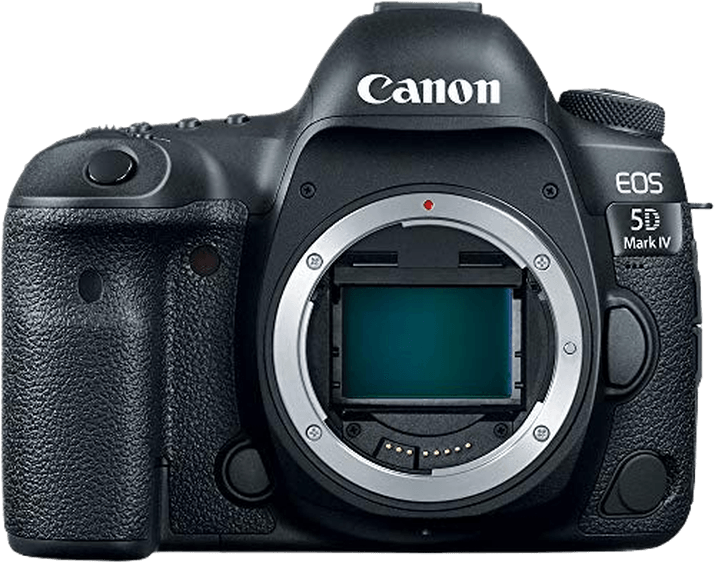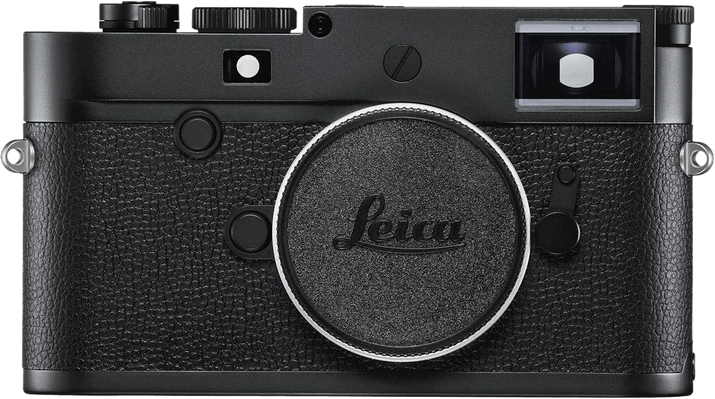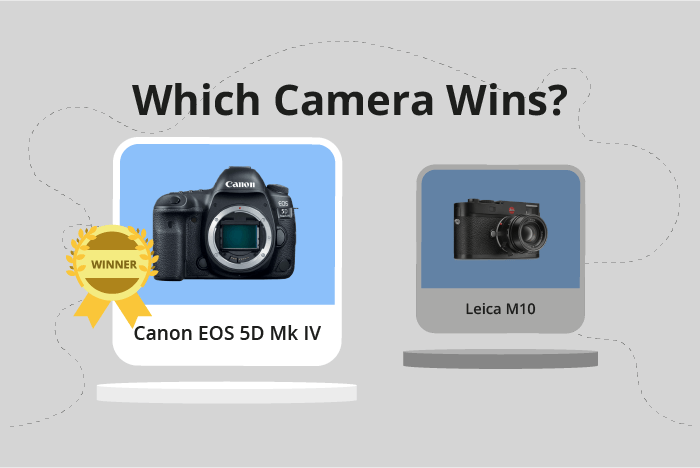Canon EOS 5D Mark IV vs Leica M10 Comparison
Canon EOS 5D Mark IV

Leica M10

The Canon EOS 5D Mark IV is the winner in this comparison, scoring 75 out of 100 points, while the Leica M10 scored 57 points. Both cameras were released in the mid-2010s, with the Canon in 2016 and Leica in 2017. They share similar sizes, with the Canon measuring 151 x 116 x 76mm and the Leica at 139 x 39 x 80mm.
The Canon EOS 5D Mark IV outperforms the Leica M10 with its higher score, offering better overall specifications. The Leica M10, however, has its advantages, such as being lighter, weighing 660g compared to the Canon’s 890g. This makes it more portable and easier to handle.
Despite the Leica’s portability, the Canon EOS 5D Mark IV’s superior performance and lower launch price of $3,500 compared to the Leica M10’s $6,895 make it the better choice for most photographers. Both cameras have their strengths, but the Canon ultimately takes the lead in this comparison.
Canon EOS 5D Mark IV vs Leica M10 Overview and Optics
The Canon EOS 5D Mark IV outperforms the Leica M10 in optics with a score of 76/100, compared to the Leica M10’s 67/100. Both cameras share certain specifications, such as a CMOS sensor, full-frame sensor size, and lack of image stabilization. However, they differ in other aspects, which contribute to the Canon’s higher score.
The Canon EOS 5D Mark IV has a higher megapixel count at 30.4, compared to the Leica M10’s 24 megapixels. This results in more detailed and higher resolution images. The Canon also has a faster shooting speed of 7 frames per second, allowing for better capture of fast-moving subjects. Its processor, the Digic 6+, contributes to its improved performance, and the DXOMARK score for its sensor is 91, five points higher than the Leica M10’s 86. These factors make the Canon EOS 5D Mark IV a more versatile and powerful camera in terms of optics.
On the other hand, the Leica M10 offers a unique lens mount system, the Leica M, which allows for compatibility with a range of high-quality Leica lenses. While this is an advantage to some users, it may not be as significant as the higher megapixel count and shooting speed offered by the Canon EOS 5D Mark IV.
Taking these factors into account, it is clear that the Canon EOS 5D Mark IV has superior optics compared to the Leica M10. The higher resolution, faster shooting speed, and better sensor performance make it a more powerful and versatile camera. However, users who value the Leica M lens system may still find the Leica M10 to be a suitable option.
Canon EOS 5D Mark IV vs Leica M10 Video Performance
When comparing the Canon EOS 5D Mark IV and the Leica M10 in terms of video capabilities, it is important to note that the Leica M10 does not have any video functionality. This means that for those seeking a camera with video recording capabilities, the Leica M10 is not the right choice.
On the other hand, the Canon EOS 5D Mark IV boasts impressive video capabilities. With a video score of 91 out of 100, this camera is highly rated for its video performance. The maximum video resolution is 4K, providing high-quality and detailed footage. The maximum video dimensions are 4096 x 2160, ensuring that the captured video is clear and sharp. Additionally, the camera supports a maximum video frame rate of 120fps, allowing for smooth and seamless footage.
The Canon EOS 5D Mark IV also has built-in time-lapse functionality, which is ideal for those looking to capture stunning time-lapse sequences. This feature enables users to create visually appealing and dynamic video content with ease.
Considering the video capabilities of both cameras, it is clear that the Canon EOS 5D Mark IV is the superior choice for those in need of a camera with video functionality. The Leica M10, while a high-quality camera in its own right, lacks video capabilities altogether. Therefore, potential buyers should carefully consider their specific needs and preferences when choosing between these two cameras.
Canon EOS 5D Mark IV vs Leica M10 Features and Benefits
The Canon EOS 5D Mark IV emerges as the winner in the comparison of features, scoring 74 out of 100 points, while the Leica M10 scores 44 points. Both cameras share some common features, such as the absence of a flip screen, the presence of WIFI, and the lack of Bluetooth connectivity. However, the 5D Mark IV outperforms the M10 in several areas.
The 5D Mark IV has a larger screen size of 3.2 inches compared to the M10’s 3-inch screen, providing a more comfortable viewing experience. Additionally, the 5D Mark IV boasts a higher screen resolution of 1,620,000 dots, resulting in a sharper and clearer image display than the M10’s 1,036,800 dots. The 5D Mark IV also offers a touchscreen, whereas the M10 does not, allowing for more convenient and intuitive navigation.
Another advantage of the 5D Mark IV is its GPS feature, which the M10 lacks. This enables photographers to geotag their images, making it easier to organize and locate photos based on their shooting locations.
Despite its lower feature score, the Leica M10 does have its merits. Its compact size and lighter weight make it more portable and easier to handle for extended periods compared to the 5D Mark IV. However, this does not outweigh the advantages provided by the 5D Mark IV’s superior features.
To conclude, the Canon EOS 5D Mark IV outshines the Leica M10 in terms of features, offering a larger and higher-resolution touchscreen, along with GPS functionality. While the Leica M10 is more compact and lightweight, it falls short in providing the same level of user experience and convenience as the 5D Mark IV.
Canon EOS 5D Mark IV vs Leica M10 Storage and Battery
The Canon EOS 5D Mark IV outperforms the Leica M10 in storage and battery with a score of 71/100 compared to the M10’s 13/100. Both cameras share similarities in accepting SD, SDHC, and SDXC memory cards, and neither camera offers USB charging.
The 5D Mark IV excels with its dual memory card slots (SD/SDHC/SDXC and Compact Flash) and an impressive battery life of 900 shots using the LP-E6N battery. These features provide users with ample storage capacity and extended shooting time.
On the other hand, the Leica M10 only has a single memory card slot (SD/SDHC/SDXC) and a limited battery life of 210 shots using the BP-SCL5 battery. This shorter battery life and reduced storage may hinder photographers during extended shooting sessions.
Considering these factors, the Canon EOS 5D Mark IV proves to be the superior choice for photographers who require more storage options and longer battery life. The Leica M10, with its limited storage and battery capabilities, may not be ideal for extended shooting situations.
Canon EOS 5D Mark IV vs Leica M10 – Our Verdict
Are you still undecided about which camera is right for you? Have a look at these popular comparisons that feature the Canon EOS 5D Mark IV or the Leica M10:

